Collective Bargaining: Laws, Structures, and Sectoral Differences
VerifiedAdded on 2021/06/14
|12
|1058
|518
Report
AI Summary
This report provides a detailed overview of collective bargaining, beginning with an introduction to the process and its regulation under the National Labor Relations Act (NLRA). It covers seven key areas: bargaining structure, industrial action (strikes), the role of unions, unfair labor practices, impasse, bargaining units, and dispute resolution methods like arbitration. The report also distinguishes between collective bargaining in the public and private sectors, highlighting relevant laws and regulations. It examines the rights and obligations of employers, employees, and unions, as well as the legal frameworks governing these relationships, providing a comprehensive understanding of collective bargaining principles and practices.
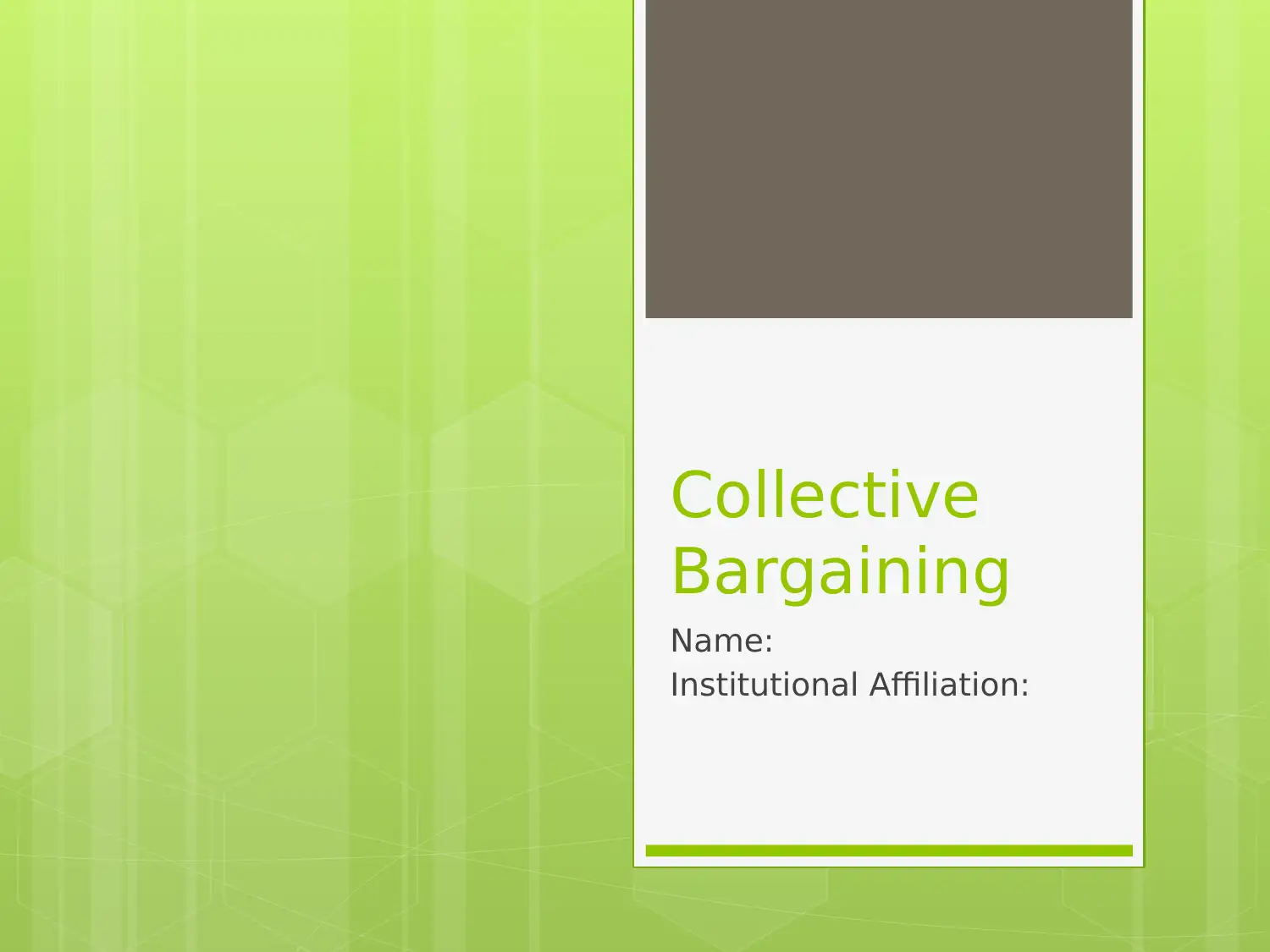
Collective
Bargaining
Name:
Institutional Affiliation:
Bargaining
Name:
Institutional Affiliation:
Paraphrase This Document
Need a fresh take? Get an instant paraphrase of this document with our AI Paraphraser
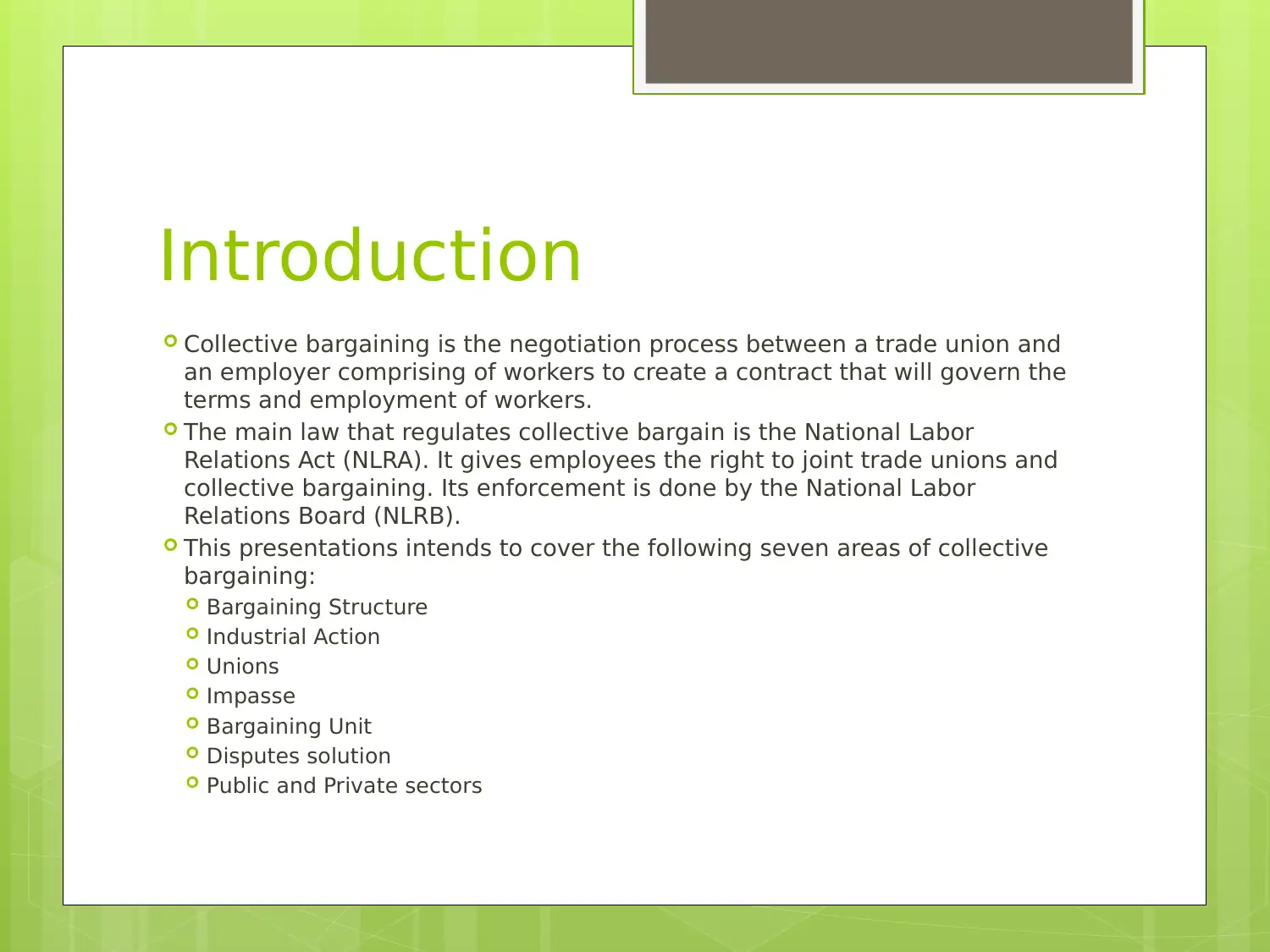
Introduction
Collective bargaining is the negotiation process between a trade union and
an employer comprising of workers to create a contract that will govern the
terms and employment of workers.
The main law that regulates collective bargain is the National Labor
Relations Act (NLRA). It gives employees the right to joint trade unions and
collective bargaining. Its enforcement is done by the National Labor
Relations Board (NLRB).
This presentations intends to cover the following seven areas of collective
bargaining:
Bargaining Structure
Industrial Action
Unions
Impasse
Bargaining Unit
Disputes solution
Public and Private sectors
Collective bargaining is the negotiation process between a trade union and
an employer comprising of workers to create a contract that will govern the
terms and employment of workers.
The main law that regulates collective bargain is the National Labor
Relations Act (NLRA). It gives employees the right to joint trade unions and
collective bargaining. Its enforcement is done by the National Labor
Relations Board (NLRB).
This presentations intends to cover the following seven areas of collective
bargaining:
Bargaining Structure
Industrial Action
Unions
Impasse
Bargaining Unit
Disputes solution
Public and Private sectors
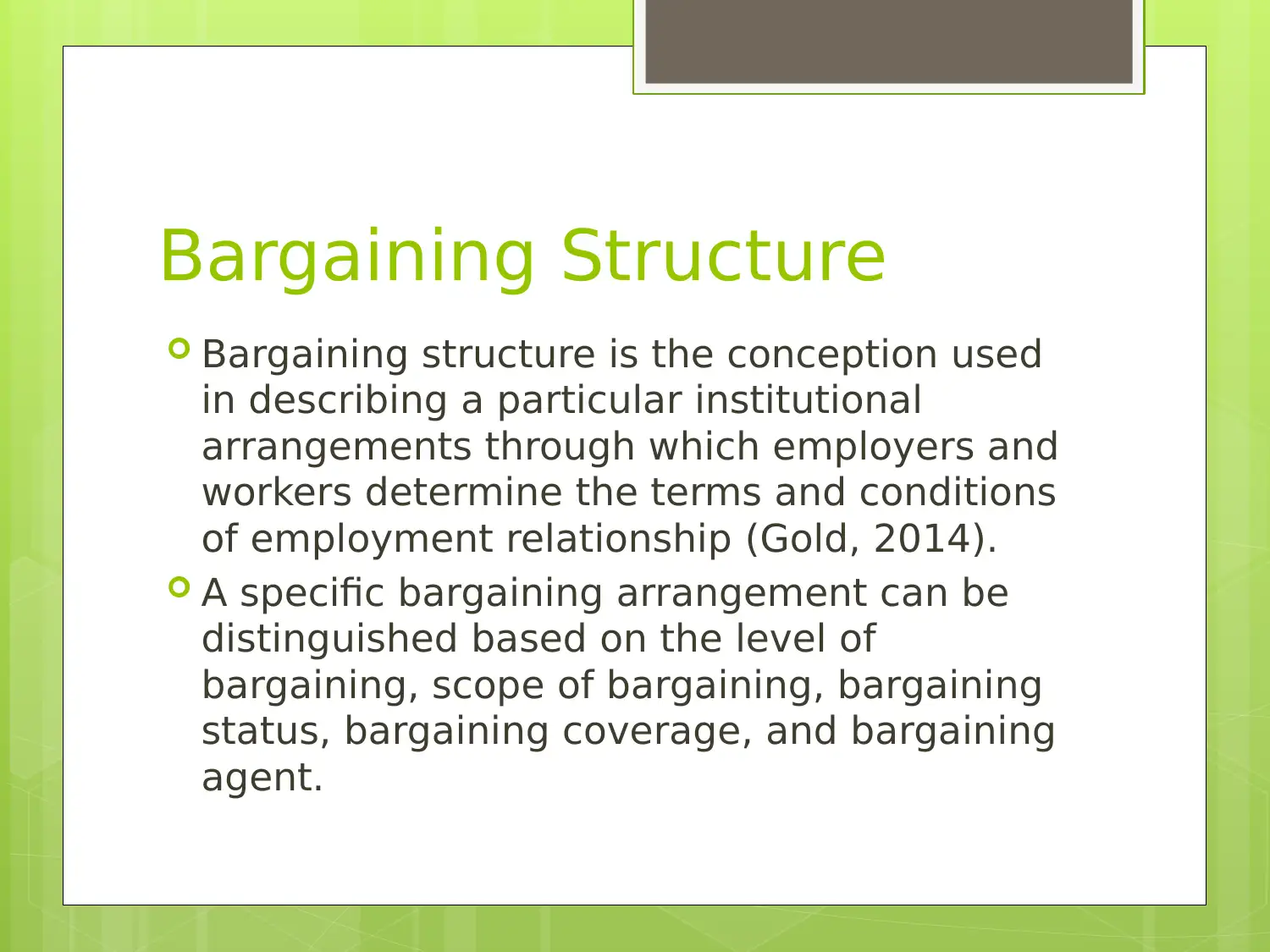
Bargaining Structure
Bargaining structure is the conception used
in describing a particular institutional
arrangements through which employers and
workers determine the terms and conditions
of employment relationship (Gold, 2014).
A specific bargaining arrangement can be
distinguished based on the level of
bargaining, scope of bargaining, bargaining
status, bargaining coverage, and bargaining
agent.
Bargaining structure is the conception used
in describing a particular institutional
arrangements through which employers and
workers determine the terms and conditions
of employment relationship (Gold, 2014).
A specific bargaining arrangement can be
distinguished based on the level of
bargaining, scope of bargaining, bargaining
status, bargaining coverage, and bargaining
agent.
⊘ This is a preview!⊘
Do you want full access?
Subscribe today to unlock all pages.

Trusted by 1+ million students worldwide
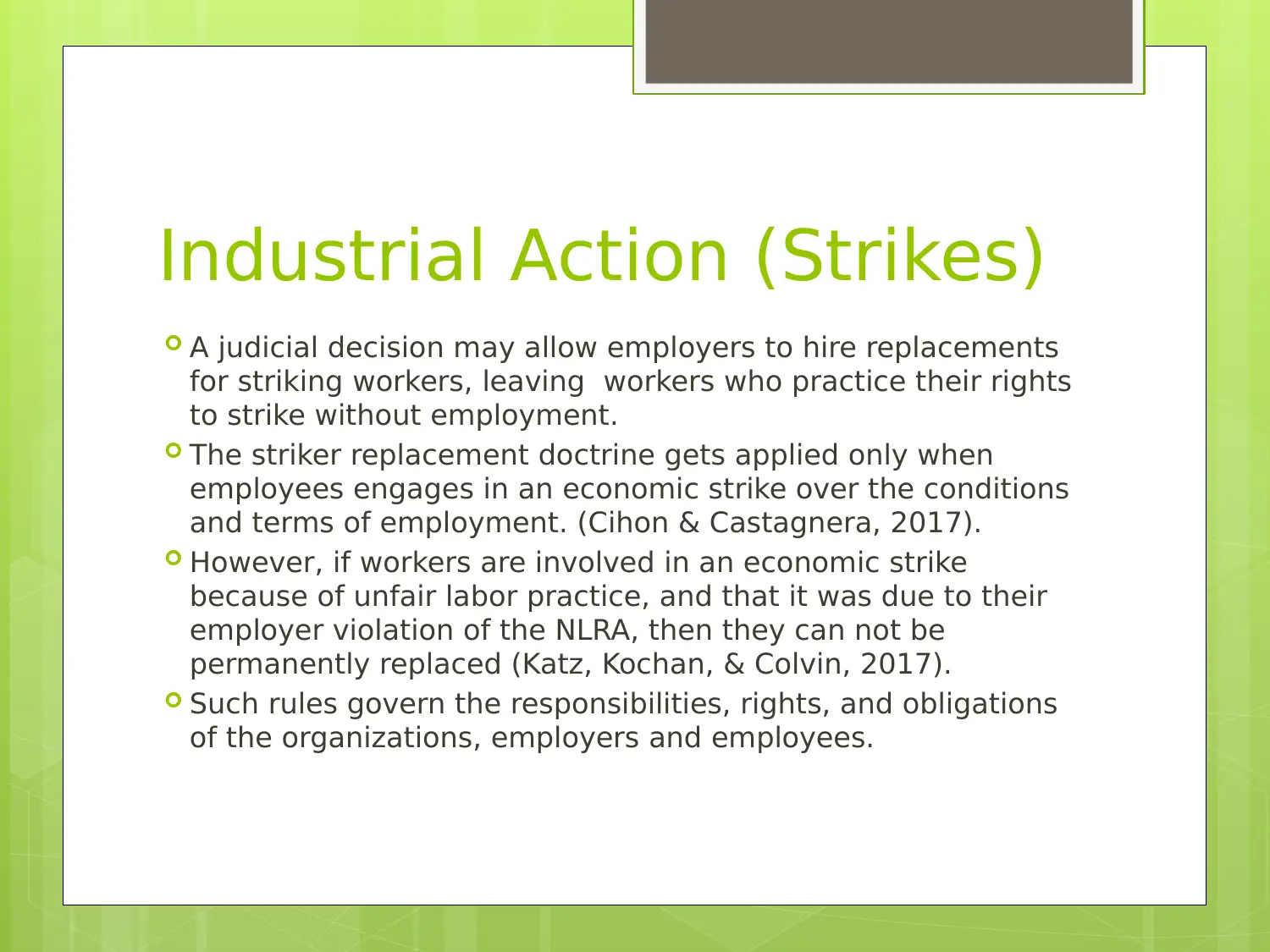
Industrial Action (Strikes)
A judicial decision may allow employers to hire replacements
for striking workers, leaving workers who practice their rights
to strike without employment.
The striker replacement doctrine gets applied only when
employees engages in an economic strike over the conditions
and terms of employment. (Cihon & Castagnera, 2017).
However, if workers are involved in an economic strike
because of unfair labor practice, and that it was due to their
employer violation of the NLRA, then they can not be
permanently replaced (Katz, Kochan, & Colvin, 2017).
Such rules govern the responsibilities, rights, and obligations
of the organizations, employers and employees.
A judicial decision may allow employers to hire replacements
for striking workers, leaving workers who practice their rights
to strike without employment.
The striker replacement doctrine gets applied only when
employees engages in an economic strike over the conditions
and terms of employment. (Cihon & Castagnera, 2017).
However, if workers are involved in an economic strike
because of unfair labor practice, and that it was due to their
employer violation of the NLRA, then they can not be
permanently replaced (Katz, Kochan, & Colvin, 2017).
Such rules govern the responsibilities, rights, and obligations
of the organizations, employers and employees.
Paraphrase This Document
Need a fresh take? Get an instant paraphrase of this document with our AI Paraphraser
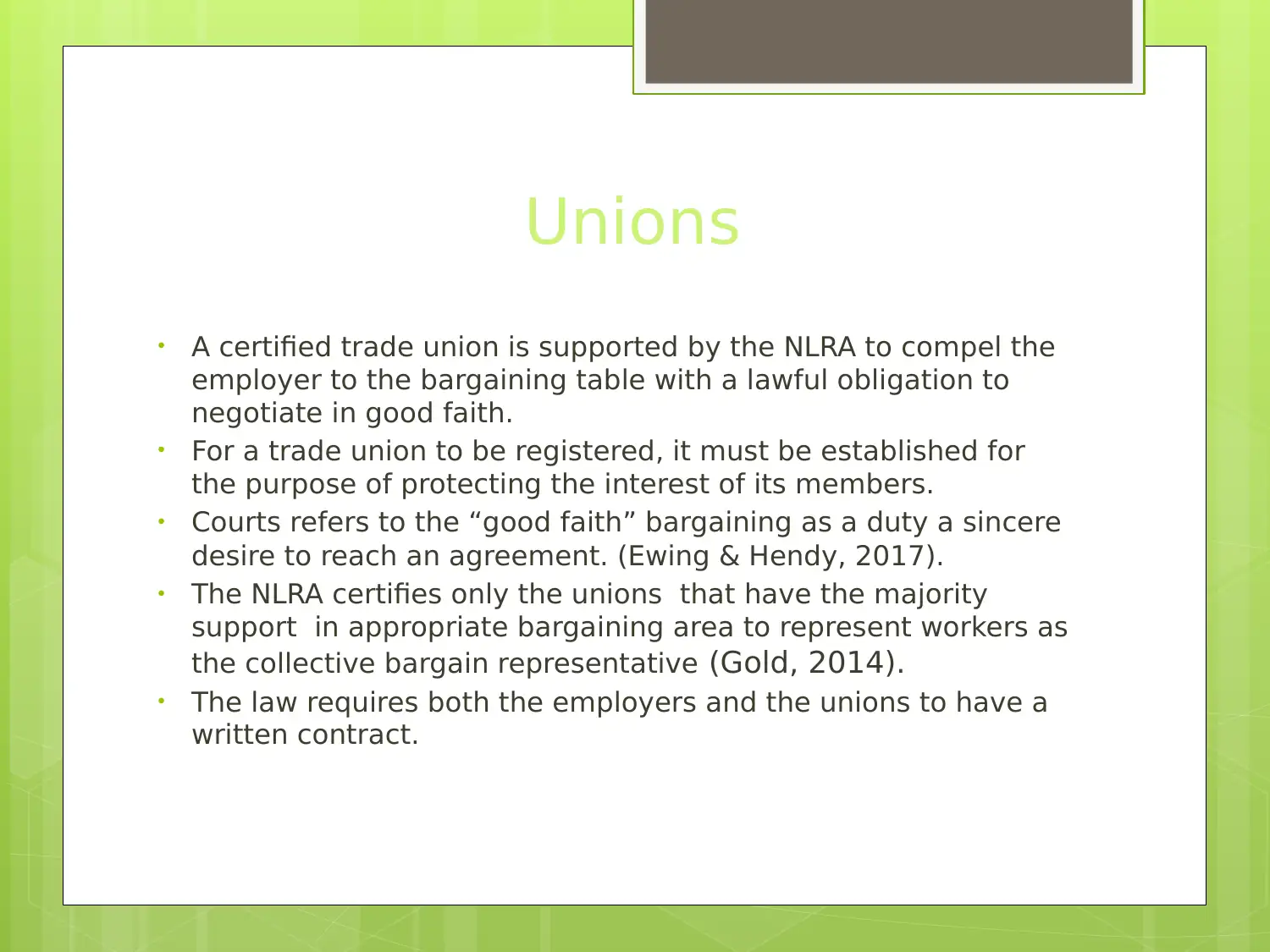
Unions
• A certified trade union is supported by the NLRA to compel the
employer to the bargaining table with a lawful obligation to
negotiate in good faith.
• For a trade union to be registered, it must be established for
the purpose of protecting the interest of its members.
• Courts refers to the “good faith” bargaining as a duty a sincere
desire to reach an agreement. (Ewing & Hendy, 2017).
• The NLRA certifies only the unions that have the majority
support in appropriate bargaining area to represent workers as
the collective bargain representative (Gold, 2014).
• The law requires both the employers and the unions to have a
written contract.
• A certified trade union is supported by the NLRA to compel the
employer to the bargaining table with a lawful obligation to
negotiate in good faith.
• For a trade union to be registered, it must be established for
the purpose of protecting the interest of its members.
• Courts refers to the “good faith” bargaining as a duty a sincere
desire to reach an agreement. (Ewing & Hendy, 2017).
• The NLRA certifies only the unions that have the majority
support in appropriate bargaining area to represent workers as
the collective bargain representative (Gold, 2014).
• The law requires both the employers and the unions to have a
written contract.

Unfair Labor Practices
The NLRA does not allow the following five unfair
labor practices:
Employees interference.
The domination of the labor organization by the
employer.
Employer's discrimination against workers involve
in union activity (Gold, 2014).
Employers refusal to bargain, and
Retaliation against the workers who have filed
unfair labor practices charges or became
witnesses in NLRB proceedings.
The NLRA does not allow the following five unfair
labor practices:
Employees interference.
The domination of the labor organization by the
employer.
Employer's discrimination against workers involve
in union activity (Gold, 2014).
Employers refusal to bargain, and
Retaliation against the workers who have filed
unfair labor practices charges or became
witnesses in NLRB proceedings.
⊘ This is a preview!⊘
Do you want full access?
Subscribe today to unlock all pages.

Trusted by 1+ million students worldwide
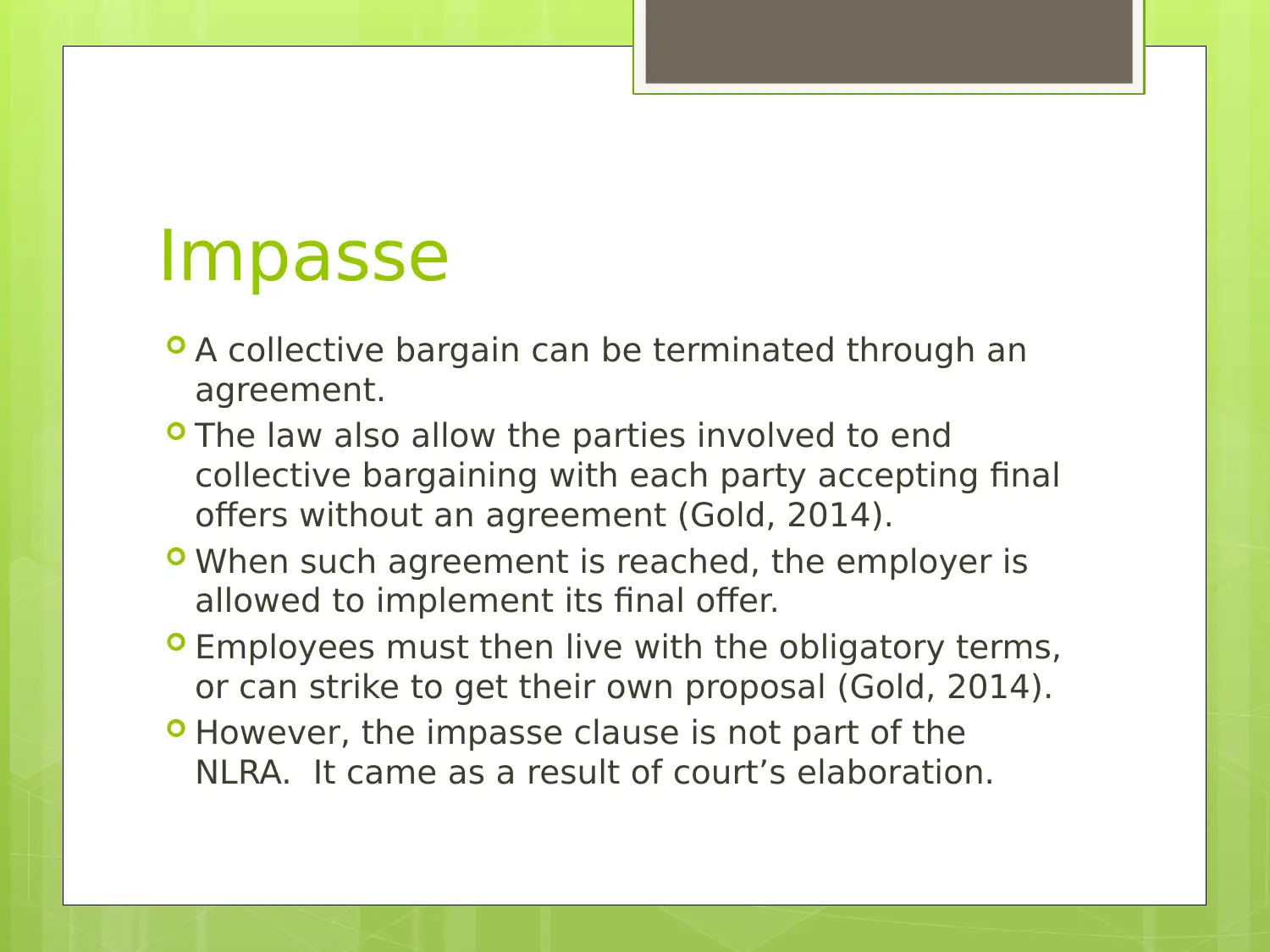
Impasse
A collective bargain can be terminated through an
agreement.
The law also allow the parties involved to end
collective bargaining with each party accepting final
offers without an agreement (Gold, 2014).
When such agreement is reached, the employer is
allowed to implement its final offer.
Employees must then live with the obligatory terms,
or can strike to get their own proposal (Gold, 2014).
However, the impasse clause is not part of the
NLRA. It came as a result of court’s elaboration.
A collective bargain can be terminated through an
agreement.
The law also allow the parties involved to end
collective bargaining with each party accepting final
offers without an agreement (Gold, 2014).
When such agreement is reached, the employer is
allowed to implement its final offer.
Employees must then live with the obligatory terms,
or can strike to get their own proposal (Gold, 2014).
However, the impasse clause is not part of the
NLRA. It came as a result of court’s elaboration.
Paraphrase This Document
Need a fresh take? Get an instant paraphrase of this document with our AI Paraphraser
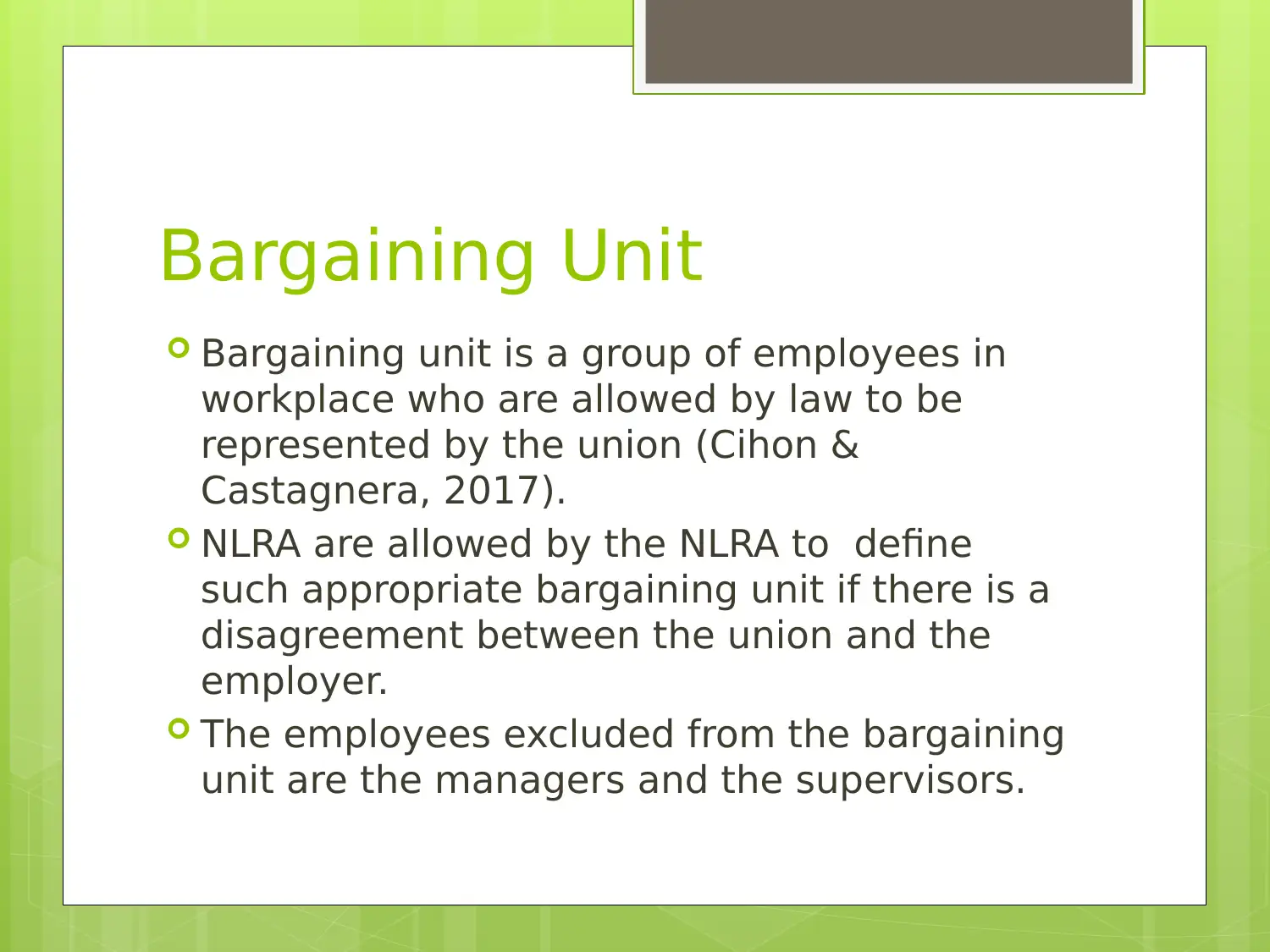
Bargaining Unit
Bargaining unit is a group of employees in
workplace who are allowed by law to be
represented by the union (Cihon &
Castagnera, 2017).
NLRA are allowed by the NLRA to define
such appropriate bargaining unit if there is a
disagreement between the union and the
employer.
The employees excluded from the bargaining
unit are the managers and the supervisors.
Bargaining unit is a group of employees in
workplace who are allowed by law to be
represented by the union (Cihon &
Castagnera, 2017).
NLRA are allowed by the NLRA to define
such appropriate bargaining unit if there is a
disagreement between the union and the
employer.
The employees excluded from the bargaining
unit are the managers and the supervisors.
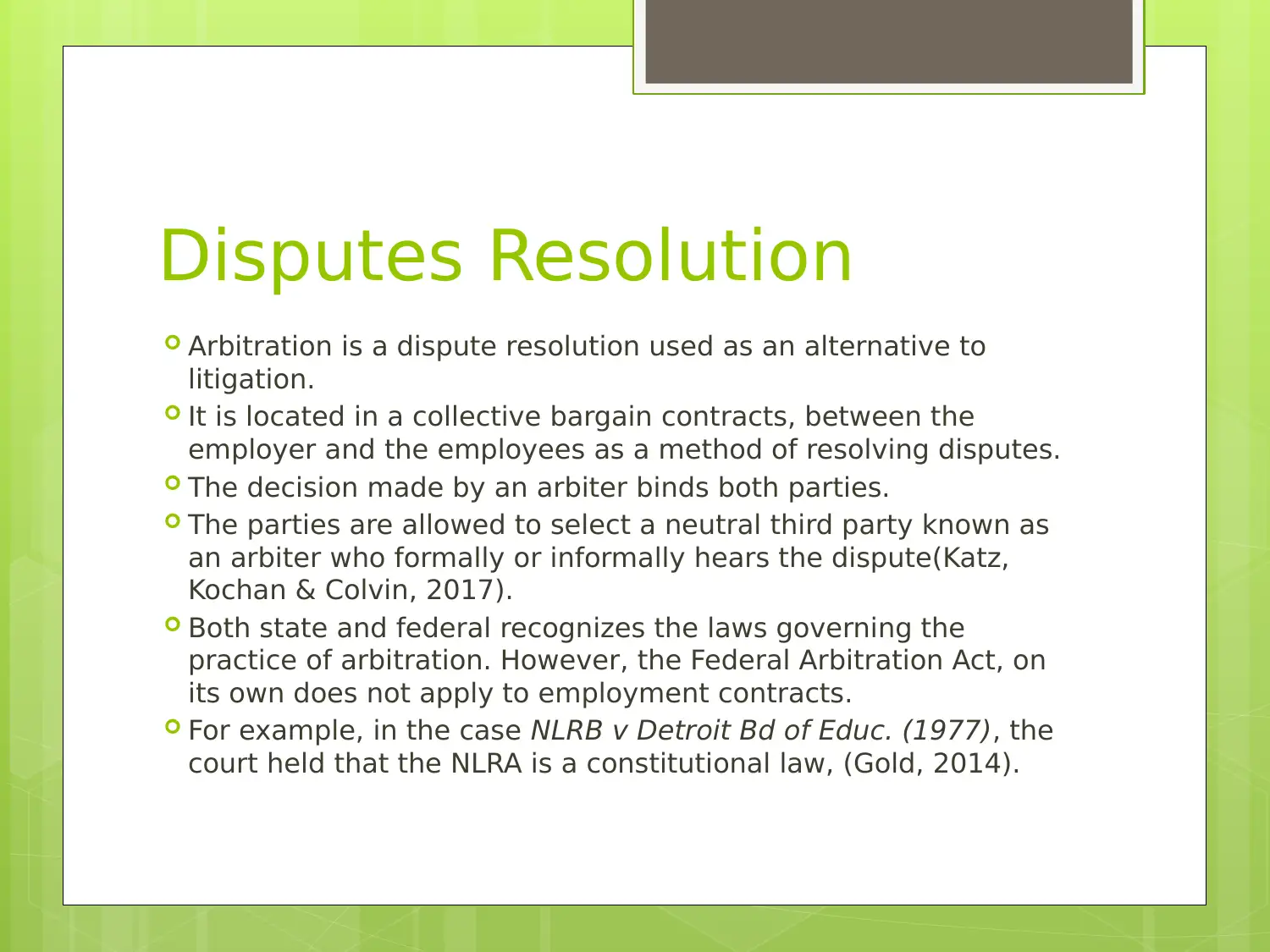
Disputes Resolution
Arbitration is a dispute resolution used as an alternative to
litigation.
It is located in a collective bargain contracts, between the
employer and the employees as a method of resolving disputes.
The decision made by an arbiter binds both parties.
The parties are allowed to select a neutral third party known as
an arbiter who formally or informally hears the dispute(Katz,
Kochan & Colvin, 2017).
Both state and federal recognizes the laws governing the
practice of arbitration. However, the Federal Arbitration Act, on
its own does not apply to employment contracts.
For example, in the case NLRB v Detroit Bd of Educ. (1977), the
court held that the NLRA is a constitutional law, (Gold, 2014).
Arbitration is a dispute resolution used as an alternative to
litigation.
It is located in a collective bargain contracts, between the
employer and the employees as a method of resolving disputes.
The decision made by an arbiter binds both parties.
The parties are allowed to select a neutral third party known as
an arbiter who formally or informally hears the dispute(Katz,
Kochan & Colvin, 2017).
Both state and federal recognizes the laws governing the
practice of arbitration. However, the Federal Arbitration Act, on
its own does not apply to employment contracts.
For example, in the case NLRB v Detroit Bd of Educ. (1977), the
court held that the NLRA is a constitutional law, (Gold, 2014).
⊘ This is a preview!⊘
Do you want full access?
Subscribe today to unlock all pages.

Trusted by 1+ million students worldwide
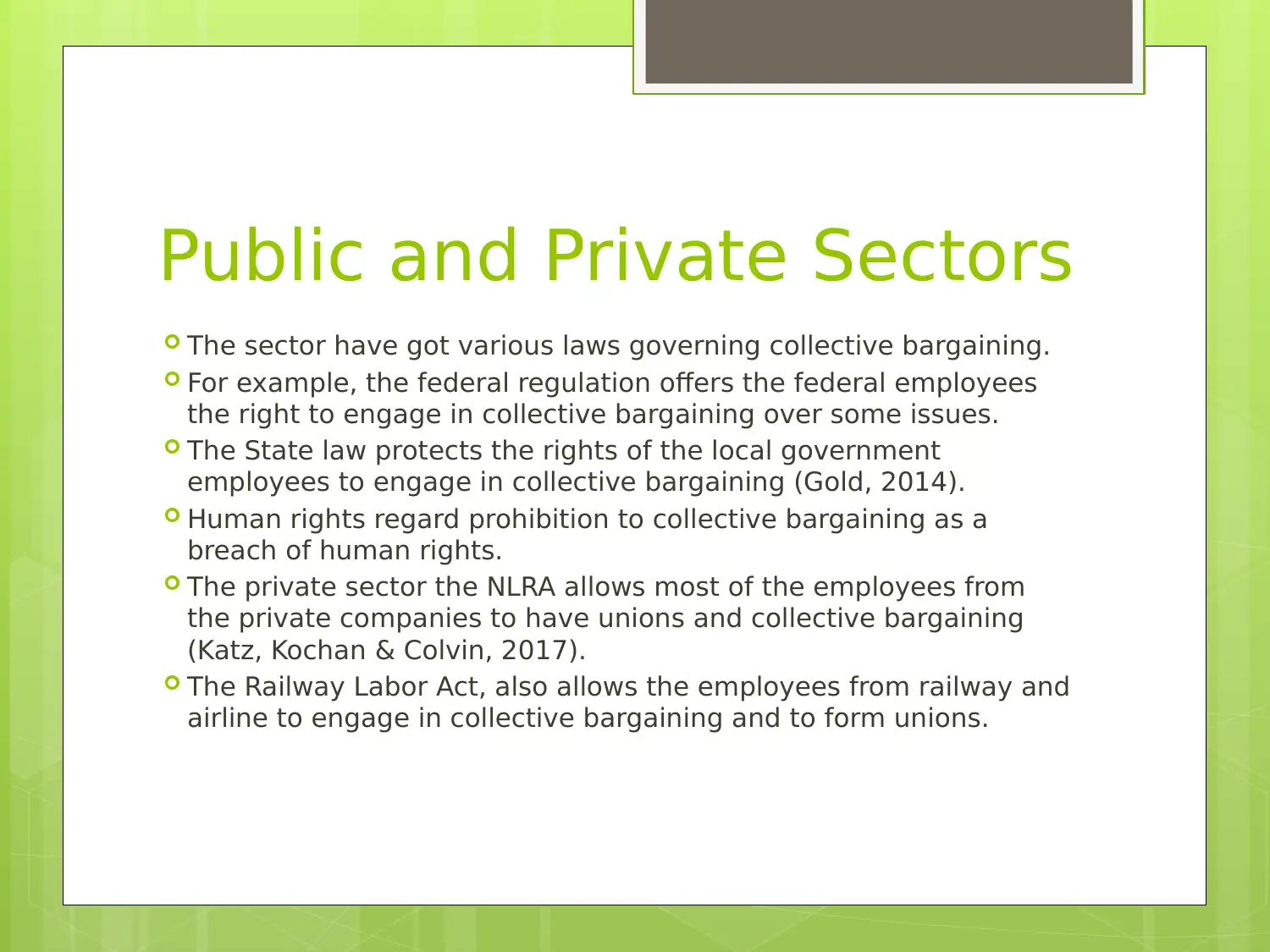
Public and Private Sectors
The sector have got various laws governing collective bargaining.
For example, the federal regulation offers the federal employees
the right to engage in collective bargaining over some issues.
The State law protects the rights of the local government
employees to engage in collective bargaining (Gold, 2014).
Human rights regard prohibition to collective bargaining as a
breach of human rights.
The private sector the NLRA allows most of the employees from
the private companies to have unions and collective bargaining
(Katz, Kochan & Colvin, 2017).
The Railway Labor Act, also allows the employees from railway and
airline to engage in collective bargaining and to form unions.
The sector have got various laws governing collective bargaining.
For example, the federal regulation offers the federal employees
the right to engage in collective bargaining over some issues.
The State law protects the rights of the local government
employees to engage in collective bargaining (Gold, 2014).
Human rights regard prohibition to collective bargaining as a
breach of human rights.
The private sector the NLRA allows most of the employees from
the private companies to have unions and collective bargaining
(Katz, Kochan & Colvin, 2017).
The Railway Labor Act, also allows the employees from railway and
airline to engage in collective bargaining and to form unions.
Paraphrase This Document
Need a fresh take? Get an instant paraphrase of this document with our AI Paraphraser
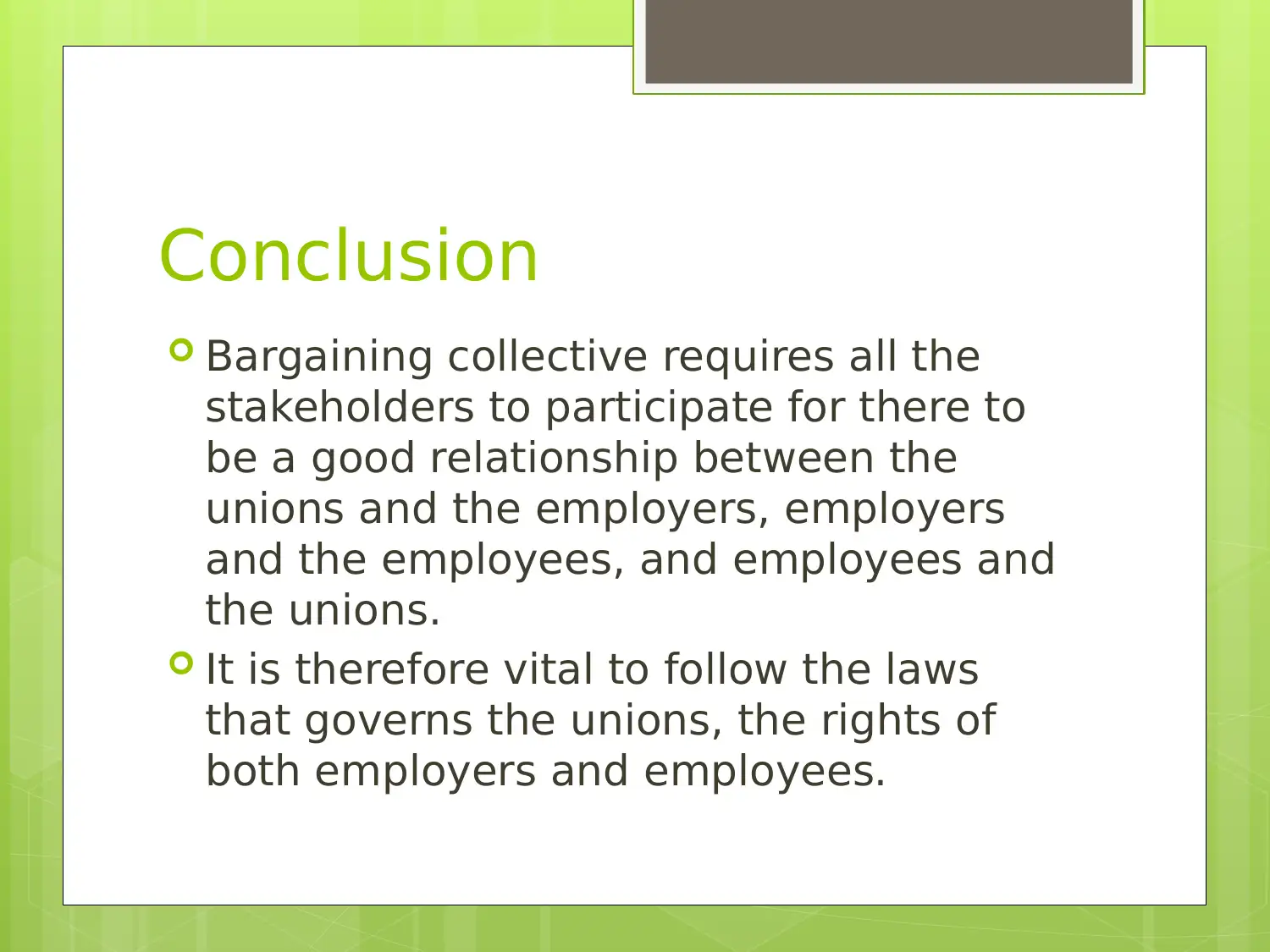
Conclusion
Bargaining collective requires all the
stakeholders to participate for there to
be a good relationship between the
unions and the employers, employers
and the employees, and employees and
the unions.
It is therefore vital to follow the laws
that governs the unions, the rights of
both employers and employees.
Bargaining collective requires all the
stakeholders to participate for there to
be a good relationship between the
unions and the employers, employers
and the employees, and employees and
the unions.
It is therefore vital to follow the laws
that governs the unions, the rights of
both employers and employees.
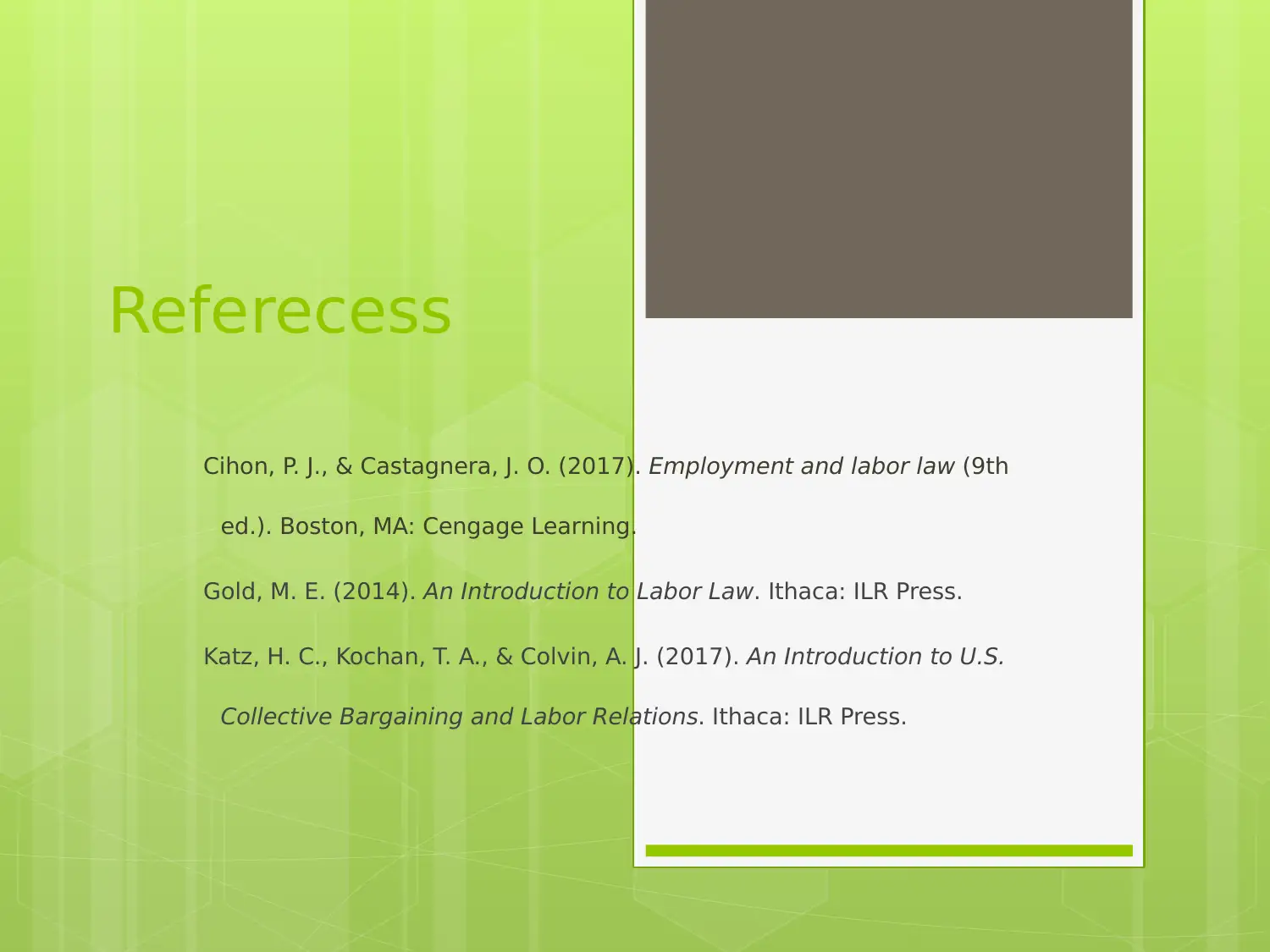
Referecess
Cihon, P. J., & Castagnera, J. O. (2017). Employment and labor law (9th
ed.). Boston, MA: Cengage Learning.
Gold, M. E. (2014). An Introduction to Labor Law. Ithaca: ILR Press.
Katz, H. C., Kochan, T. A., & Colvin, A. J. (2017). An Introduction to U.S.
Collective Bargaining and Labor Relations. Ithaca: ILR Press.
Cihon, P. J., & Castagnera, J. O. (2017). Employment and labor law (9th
ed.). Boston, MA: Cengage Learning.
Gold, M. E. (2014). An Introduction to Labor Law. Ithaca: ILR Press.
Katz, H. C., Kochan, T. A., & Colvin, A. J. (2017). An Introduction to U.S.
Collective Bargaining and Labor Relations. Ithaca: ILR Press.
⊘ This is a preview!⊘
Do you want full access?
Subscribe today to unlock all pages.

Trusted by 1+ million students worldwide
1 out of 12
Related Documents
Your All-in-One AI-Powered Toolkit for Academic Success.
+13062052269
info@desklib.com
Available 24*7 on WhatsApp / Email
![[object Object]](/_next/static/media/star-bottom.7253800d.svg)
Unlock your academic potential
Copyright © 2020–2025 A2Z Services. All Rights Reserved. Developed and managed by ZUCOL.





